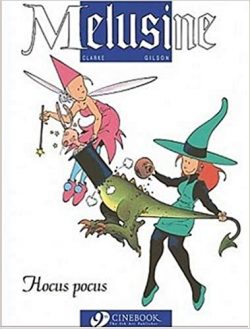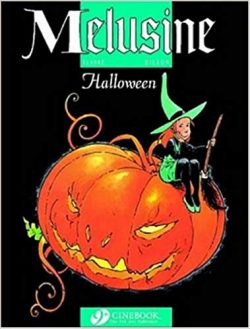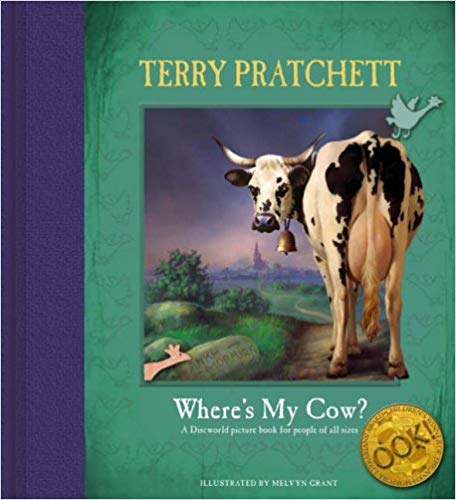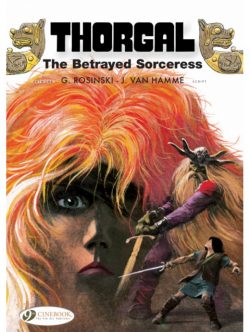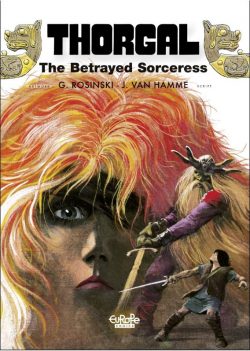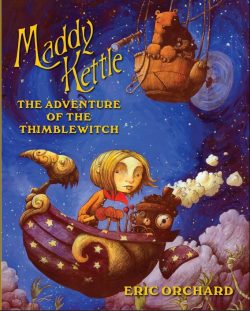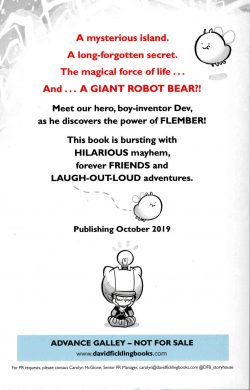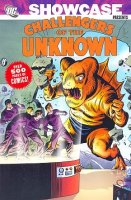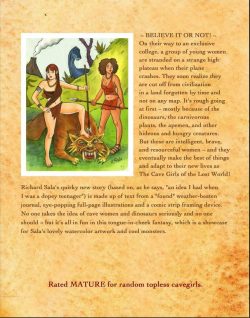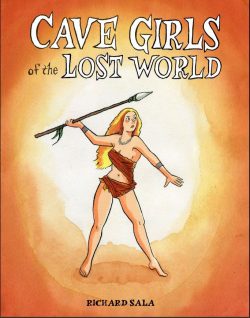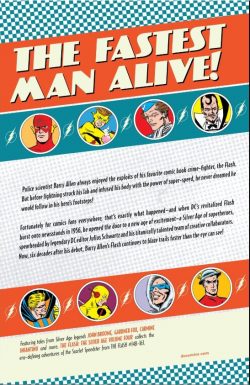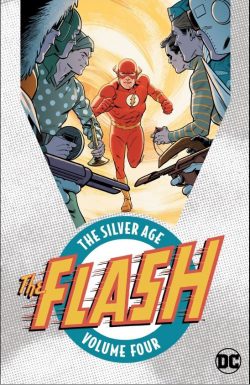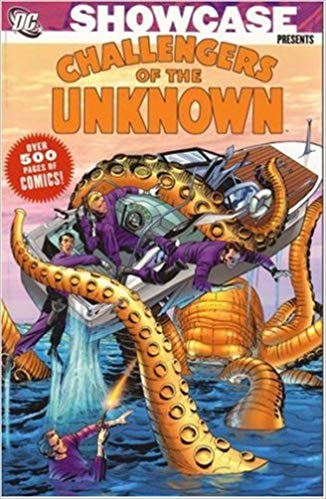
By Jack Kirby, Bob Brown, Dave Wood, Ed Herron, Roz Kirby, Marvin Stein, Bruno Premiani, George Klein, Wally Wood & various (DC Comics)
ISBN: 978-1-4012-1087-8 (TPB)
In an era where comicbooks had slipped into an undirected and formless mass of genre-niches, the Challengers of the Unknown were a bridging concept between the fashionably all-American human trouble-shooters who monopolised comicbooks for most of the 1950s and the costumed mystery men who would soon return to take over the industry.
As superheroes were being gradually revived in 1956 under the cautious aegis of Julius Schwartz, here was a super-team – the first of the Silver Age – with no powers, the most basic and utilitarian of costumes and the most dubious of motives: Suicide by Mystery.
Despite all that they were a huge hit and struck a chord that lasted for more than a decade before they finally died… only to rise again and yet again. The idea of them was stirring enough, but their initial execution made their success all but inevitable.
Jack Kirby was – and remains – the most important single influence in the history of American comics. There are, quite rightly, millions of words written about what the man has done and meant, and you should read those if you are at all interested in our medium. I’m going to add even more words to that superabundance in this review of one of his best projects, which like so many others, he perfectly constructed before moving on as he always did, leaving highly competent but never quite as inspired talents to build upon his legacy.
When the comic industry suffered an economic collapse in the mid 1950’s, Kirby’s partnership with Joe Simon ended and he returned briefly to DC Comics. Here he worked on mystery tales and the minority-interest Green Arrow back-up strip whilst creating newspaper strip Sky Masters of the Space Force.
Never idle for a moment, he also re-packaged for Showcase (a try-out title that launched the careers of many DC mainstays) an original super-team concept that had been kicking around in his head since he and collaborator Simon had closed their innovative but unfortunate Mainline Comics.
After years of working for others, Simon and Kirby had finally established their own publishing company, producing comics for a much more sophisticated audience, only to find themselves in a sales downturn and awash in public hysteria generated by the anti-comic book witch-hunt of US Senator Estes Kefauver and psychologist Dr Fredric Wertham.
Simon moved into advertising, but Kirby soldiered on, taking his skills and ideas to a number of safer, if less experimental, companies.
The Challengers of the Unknown were four ordinary mortals; heroic adventurers and explorers who walked away unscathed from a terrible plane crash. Clearly what we now call “adrenaline junkiesâ€, they decided that since they were all living on borrowed time, they would dedicate what remained of their lives to testing themselves and fate. They would risk their lives for Knowledge and, naturally, Justice.
The Kirby tales of the team have been thankfully immortalised in full-colour archival print and digital editions, but the team captivated readers for a decade beyond those glorious beginnings, and thus far those tales are only available in these monochrome tomes. Hope springs eternal, though…
The series launched with ‘The Secrets of the Sorcerer’s Box!’ (Showcase #6, cover-dated January/February 1957 – which meant it came out in time for Christmas 1956). Kirby and scripter Dave Wood, plus inkers Marvin Stein and Jack’s wife Roz, crafted a spectacular epic as the doom-chasers are hired by duplicitous magician Morelian to open an ancient container holding otherworldly secrets and powers.
This initial story roars along with all the tension and wonder of the B-movie thrillers it emulates and Kirby’s awesome drawing resonates with power and dynamism. That continues for the sequel, a science fiction drama sparked by an alliance of Nazi technologies and American criminality which unleashes a terrible robotic monster. ‘Ultivac is Loose!’ (Showcase #7, dated March/April 1957) introduces beautiful and capable boffin (aren’t they always?) Dr. June Robbins, who becomes the unofficial fifth Challenger at a time when most comic females (and living ones too) – had been banished back to subsidiary domestic status in that so-conservative era.
The team didn’t reappear until Showcase #11 (November/December 1957) as The Flash and Lois Lane got their shots at the big time. When the Challs did return, it was in alien invasion adventure ‘The Day the Earth Blew Up’, with unique realist Bruno Premiani inking a taut doomsday chiller pinning readers to the edges of their seats even today, and by the time of their last Showcase outing (#12, January /February 1958) they had won their own title.
‘The Menace of the Ancient Vials’ was defused by the usual blend of daredevil heroics and ingenuity (with the wonderful inking of George Klein adding subtle clarity to the tale of an international criminal who steals an ancient weapons cache that threatens the entire world if misused), but the biggest buzz came two months later with the debut of their own magazine.
Issue #1, written and drawn by Kirby, with Stein on inks, presented two complete stories plus an iconic introductory page that would become almost a signature second logo for the team.
‘The Man Who Tampered with Infinity’ pits the heroes against a renegade scientist whose cavalier dabbling liberates dreadful monsters from the beyond onto our defenceless planet, after which the team are abducted by aliens to become ‘The Human Pets’.
The same creators were responsible for a brace of thrillers in #2. ‘The Traitorous Challenger’ is a monster mystery, with June returning to sabotage a mission in the Australian Outback, whilst ‘The Monster Maker’ finds the team seemingly helpless against a super-criminal who can conjure up and animate solid objects out of his thoughts.
The third issue features ‘Secret of the Sorcerer’s Mirror’ with Roz Kirby & Marvin Stein again inking the mesmerising pencils, as the boys pursue a band of criminals whose magic looking glass can locate deadly ancient weapons, although the most intriguing tale for fans and historians is undoubtedly ‘The Menace of the Invincible Challenger’.
Here team strongman Rocky Davis is rocketed into space, only to crash back to Earth with strange, uncanny powers.
For years the obvious similarities of this group – and especially this adventure – to the origin of Marvel’s Fantastic Four (FF #1 came out in the autumn of 1961) have fuelled speculation. In all honesty, I simply don’t care. They’re both similar and different but equally enjoyable, so read both. In fact, read them all.
With #4 the series became artistically perfect as the sheer luminous brilliance of Wally Wood’s inking elevated the art to unparalleled heights. The scintillant sheen and limpid depth of Wood’s brushwork fostered an abiding authenticity in even the most outrageous of Kirby’s designs and the result is – even now – breathtaking.
‘The Wizard of Time’ is a full-length masterpiece wherein a series of bizarre robberies leads the team to a scientist with a time-machine. By visiting oracles of the past, he finds a path to the far future. When he gets there, he plans on robbing it blind, but the Challengers find a way to follow him…
‘The Riddle of the Star-Stone’ (#5) is a contemporary full-length thriller, wherein an archaeologist’s assistant uncovers an alien tablet bestowing various super-powers when different gems are inserted into it. The exotic locales and non-stop spectacular action are intoxicating, but the solid characterisation and ingenious writing are what make this such a compelling read.
Scripter Dave Wood returned for #6’s first story. ‘Captives of the Space Circus’ has the boys kidnapped from Earth to perform in a interplanetary show, but the evil ringmaster is promptly outfoxed and the team returns for Ed Herron’s mystic saga ‘The Sorceress of Forbidden Valley’, as June becomes an amnesiac puppet in a power struggle between a fugitive gangster and a ruthless feudal potentate.
There are also two stories in #7. Herron scripted both the relatively straightforward alien-safari tale ‘The Beasts from Planet 9’ and much more intriguing ‘Isle of No Return’ with the team confronting a scientific bandit before his shrinking ray leaves them permanently mouse-sized.
Issue #8 is a magnificent finale to a superb run, as Kirby & Wally Wood go out in style via two gripping spectaculars (both of which introduce menaces who would return to bedevil the team in future tales).
‘The Man Who Stole the Future’ by Dave Wood, Kirby and the (unrelated) Wally, introduces Drabny – a mastermind who steals mystic artefacts and conquers a small nation before the lads hand him his marching orders. This is a tale of blistering battles and uncharacteristic, if welcome, comedy, but the true gem is science fiction tour-de-force ‘Prisoners of the Robot Planet’, with art by Kirby & Wally, and most probably written by Kirby & Herron. Petitioned by a desperate alien, the Challs travel to his distant world to liberate the population from bondage to their own robotic servants, who have risen in revolt under the command of fearsome automaton Kra.
These are classic adventures, told in a classical manner. Kirby developed a brilliantly feasible concept with which to work and heroically archetypical characters in cool pilot Ace Morgan, indomitable strongman Rocky, intellectual aquanaut “Profâ€. Haley and daredevil acrobat Red Ryan. He then manipulated, mixed and matched an astounding blend of genres to display their talents and courage in unforgettable exploits that informed every team comic that followed, and certainly influenced his successive and landmark triumphs with Stan Lee. But then he left.
The Challengers would follow the Kirby model until cancellation in 1970, but, due to a dispute with Editor Jack Schiff the writer/artist resigned at the height of his powers. The Kirby magic was impossible to match, but as with all The King’s creations, every element was in place for the successors to run with.
Challengers of the Unknown #9 (September 1959) saw an increase in the fantasy elements favoured by Schiff, and perhaps an easing of the subtle tension and inter-group fractious bickering that marked previous issues (Comics Historians take note: the Challs were snapping and snarling at each other years before Marvel’s Cosmic Quartet ever boarded that fateful rocket-ship).
A number of writers, many sadly lost to posterity, stepped in, including Bill Finger, Ed Herron and possibly Jack Miller, Bob Haney and Arnold Drake, but one man took over the illustrator’s role: Bob Brown.
Brown was born August 22nd 1915 and he died in 1977 following a long illness. He studied at Hartford Art School and Rhode Island School of Design, and worked with his showbiz folks and sister in a song-&-dance act from 1927 onwards. He was drafted in 1940 – the year he also began working as a comics artist and scripter for Fox, Timely/Atlas. As the war intensified, he was an aircraft radio operator, an aviation cadet and served in the Pacific as bombardier and navigator in B-29 bombers, earning six air medals and a Distinguished Flying Cross.
After jobbing around the industry during the late 1040s and 1950’s Brown settled at National Comics/DC, co-created the long-running Space Ranger, drawing Tomahawk, western hero Vigilante, Batman, Superboy, Doom Patrol, World’s Finest Comics and a host of other features and genre shorts. He moved to Marvel in the 1970s where he drew Warlock, Daredevil and the Avengers among others.
He was a consummate professional and drew every issue of the Challengers from #9-63: almost a decade of high adventure ranged from ravaging aliens, cute-and-fuzzy space beasts to truly scary supernatural horrors.
‘The Men who Lost their Memories’ finds the team fighting crooks with a thought-stealing machine, whereas ‘The Plot to Destroy Earth!’ is a full-on, end-of-humanity thriller with monsters bent on carving our world into chunks for their resource-hungry alien masters. Only the guts and ingenuity of our heroes can save the day…
A destructive giant with a deadly secret is the motivating premise of ‘The Cave-Man Beast’ and #10’s cover-featured second tale sets another time-travel conundrum as the boys discover their own likenesses on a submerged monolith in fanciful thriller ‘The Four Faces of Doom’.
Issue #11 is an action-packed full-length interdimensional romp subdivided into ‘The Creatures from the Forbidden World’, ‘Land beyond the Light’ and ‘The Achilles Heel’, after which the two-story format returns for the next issue, which boasts ‘The Challenger from Outer Space’ – with an alien superhero joining the team – and ‘Three Clues to Sorcery’ with our quarrelsome quartet again forced to endure exotic locales and extreme perils to acquire mystic artefacts for a criminal mastermind. Even so, this time there’s a unique and deadly twist in this oft-told tale…
‘The Prisoner of the Tiny Space Ball’ see the team rescuing the ruler of another world, before Rocky is possessed by the legendary Golden Fleece, making him a puppet of ‘The Creatures from the Past’.
Issue #14 opens with one of the few adventures with a credited scripter. Ed “France†Herron was a 30-year comics veteran and ‘The Man who Conquered the Challengers’ is one of his best tales, with crooked archaeologist Eric Pramble stealing an ancient formula for “liquid light†which makes him functionally immortal. Moreover, every time he’s killed, he reanimates with a different super-power!
As Multi-Man, Pramble became the closest thing to an arch-villain the series ever had, and even graduated to becoming a regular foe across the DCU. Once again, cool wits and sheer nerve find a way to victory that sheer firepower never could.
In second yarn ‘Captives of the Alien Beasts’, all five Challs are teleported to another world by animals who have invaded a scientist’s laboratory. It’s a relatively innocuous tale when compared to #15’s all-out fight-fest ‘The Return of Multi-Man’ and bizarre offering ‘The Lady Giant and the Beast’, wherein June is transformed into a 50-foot leviathan just as a scaly monster cuts a swathe of destruction through the locality.
Issue #16’s ‘Incredible Metal Creature’ sees an Earth thug join forces with an escaped alien criminal. No real Challenge there, but a back-up yarn finds the team in Arabia as ‘Prisoners of the Mirage World’ facing knights who have been trapped there since the time of the Crusades.
This thrill-stuffed then tome concludes with #17’s supernatural crime whimsy ‘The Genie who Feared June’, and interplanetary mission of mercy ‘The Secret of the Space Capsules’; both solid pieces of adventure fiction that, if not displaying the unique Kirby magic, are redolent with its flavours.
As well as being probably (certainly at this moment, anyway) my favourite comics series, Challengers of the Unknown is sheer escapist wonderment, and no fan of the medium should miss the graphic exploits of these perfect adventurers in the ideal setting of not so long ago in a simpler better world than ours. If only we could convince DC Comics to give them the archival home in print and digital editions they so richly deserve, to match the constant re-imaginings the team and title regularly enjoy…
© 1957, 1958, 1959, 1960, 1961, 2006 DC Comics. All Rights Reserved.
